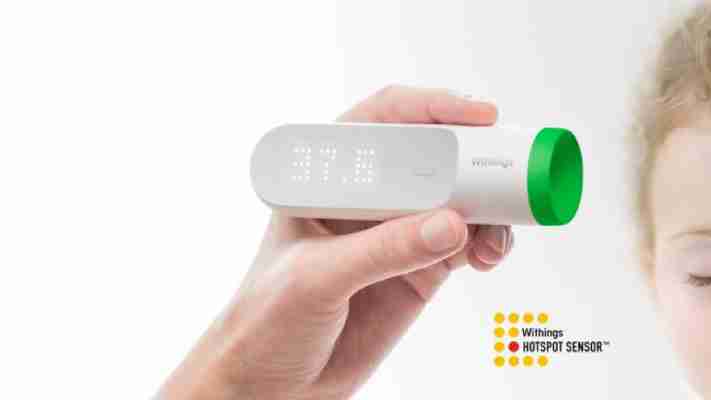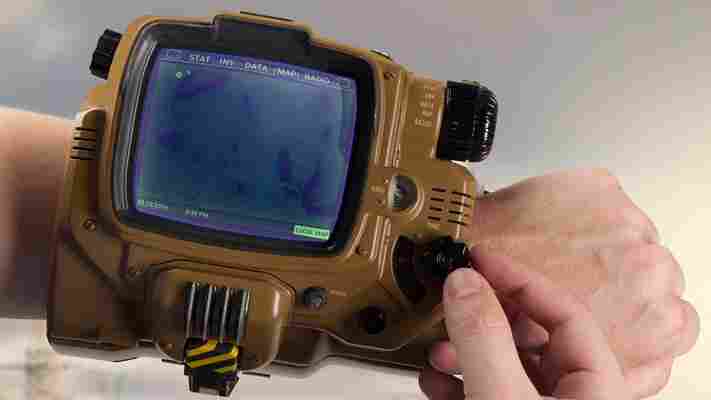You can now buy the (surprisingly amazing) Withings Thermo contactless thermometer
Withings Thermo , the company’s flashy FDA-approved contactless thermometer, is now available for purchase.

Thermo allows you to scan the forehead and temporal artery to get a temperature, and it doesn’t need to come into contact with the skin. Withings says Thermo can be up to half an inch away and still get an accurate reading.
The device links to an app, which lets you view and manage several family members. Each reading can also be annotated with notes on how a person is feeling, a list of symptoms or which medications they may be taking.
The Withings Thermo itself also keeps track of those profiles for cataloging purposes. Once a temperature is taken, it can be assigned to a member of your family — which is great for those times everyone is ill.
Using 16 infrared sensors, Thermo takes up to 4,000 measurements in under two seconds to detect the hottest point on your skin. To get a reading, you start from the center of the forehead and move toward either side.
I’ve had a Withings Thermo for testing purposes for a few days, and it’s as good as advertised. I was dubious of Withings’ claims, but Thermo holds up to scrutiny.
Setup via the app is a bit clumsy; Thermo wants to turn off to save battery life (it takes two AAA), but the app often takes longer than its on-time to set everything up. It took me a few tries, but there’s not much to it, and the on-screen directions walk you through each step with ease.
The app (iOS or Android) is gorgeously laid out and easy to use. There really isn’t any way to get confused by it. You take a temperature, it loads into the app, and you’re free to leave it or make notes on that temperature.
While you may not be using Thermo day-to-day, it’s still a handy all-in-one experience for those times you need it. I’d rather be able to enter the emergency room, doctor’s office or urgent care with data instead of guessing as to how long I’ve felt bad or had a high temperature.
If you’re interested in updating your thermometer, Thermo is $99.95, and available from Withings or in the Apple Store. It’s not the most cost-effective upgrade, but I like its ease of use, accuracy and app.
Fallout fans can now buy an official Pip-Boy replica that receives calls and texts
Trying to survive In the wake of a nuclear war isn’t easy – but in Fallout’s fictional setting, the Pip-Boy 3000 Mk IV wearable makes things a little easier by showing you your health stats, maps, inventory of items and even acting as a Geiger counter on your wrist.

Wouldn’t it be grand to have one in real life? Last year, Bethesda released a replica that was little more than a case for your phone. Now, it’s upped its game with an even better version that has an integrated screen and its own ‘on-board software and hardware.’
Limited to 5,000 pieces, the Pip-Boy Deluxe Bluetooth Edition runs Pip-OS and pairs with your phone to let you make calls, read incoming texts and play music.
All its knobs, dials and buttons work, and it also has a Cosplay mode to display Status, Special and Perks screens that will be familiar to Fallout fans. When not in use on your wrist, it doubles up as an alarm clock.
You’ll be hard-pressed to find cooler Fallout memorabilia than this. The $350 device ships in November from ThinkGeek and comes with a RobCo Industries stand that has its own speakers, as well a Capsule-Case inspired tin to store it.
Microsoft HoloLens comes with these holographic games
It’s official: Microsoft’s HoloLens costs $3,000 for developers and will ship in just 30 days on March 30.

The device ships with a number of apps and games bundled, for free, so developers are able to get an idea of what the device is capable.
The first, called Fragments , is a “mixed reality crime drama” which takes place in your own living room. It detects objects in the room and uses it as a set to tell the story — it seriously looks amazing.
Another game called Young Conker tries to mix platform-style gaming with holograms to let a tiny fox run around your living room and use walls, objects and the floor as the actual level. That allows you to play an entirely different game by just going to a new room, as HoloLens adapts the layout to your surroundings.
The final game, RoboRaid, was built during a hack week at Microsoft. It’s a first-person shooter that fires at you from your environment and lets you dodge the bullets using natural movements. It leverages 3D sound to use the entire room, so projectiles can come from behind you.
The games look like impressive technology demos for a device that’s likely incredibly unfinished, and are a way the company can educate developers about what’s possible with the device.
HoloLens will eventually become a consumer gadget, but Microsoft is yet to announce pricing or availability for wider audiences.
